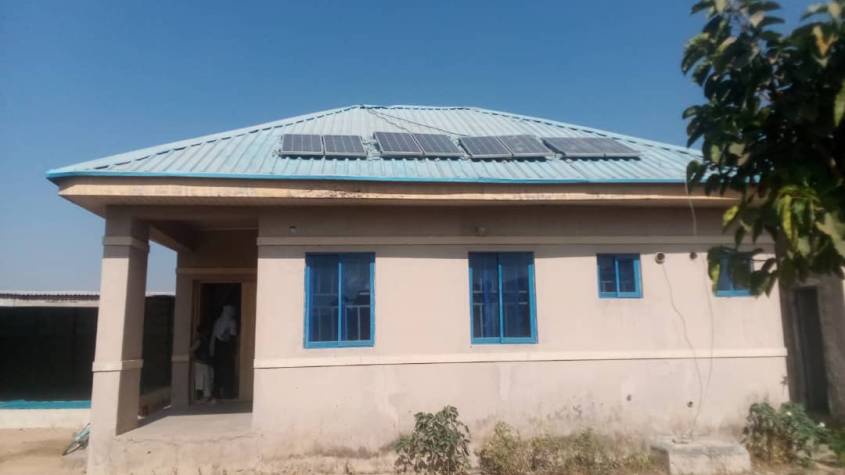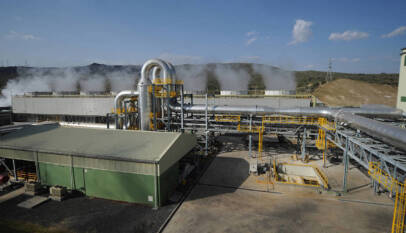SOJO | How Solar Power is Revolutionizing Access to Healthcare in Rural Nigeria
Thanks to a partnership between the Dangote Foundation and UNICEF, Tanawa Health Post was among Nigerian healthcare facilities connected with solar electricity systems, guaranteeing uninterrupted power supply and revolutionizing access to health care in the community.

On a cold 2020 winter night in Tanawa, a quiet rural town in Kano, northwestern Nigeria, Furaira Iliyasu went into labor. The closest functional health facilities — the Kura Primary Health Centre (PHC) and Kura General Hospital—were more than five kilometers away, making it impossible for her to reach them in time.
As her contractions intensified, the responsibility of saving her life and that of her unborn baby fell to the officer on duty at Tanawa Health Post, a modest facility ill-equipped to handle such emergencies. Supported by a midwife, the health officer jumped into action undeterred by the dire circumstances. In the absence of electricity, the duo relied on the faint glow of a small torch to guide them through the delicate process.
Against all odds, Furaira delivered a healthy baby boy, a testament to the skill and determination of the health workers at the Tanawa Health Post. “It was terrifying. Yet the health personnel worked effectively under the gloomy darkness. I kept wondering, ‘What if something goes wrong?’” Furaira remembered.
The lack of reliable power supply at Tanawa Health Post was not an isolated case; it highlights a systemic problem affecting millions of rural Nigerian healthcare facilities and hindering the effective delivery of essential healthcare services to pregnant women such as Furaira. The consequences of these infrastructural deficits are far-reaching – from dimly lit delivery rooms to the inability to refrigerate vaccines and power diagnostic equipment.
For mothers like Furaira, it was a matter of life and death, as ill-equipped health facilities place both them and their newborns at risk of losing their lives. Until just a few years past, Tanawa was devoid of electricity, rendering childbirth services impossible and exposing women like Furaira to life-threatening complications. Her experience highlights the broader challenges health workers and patients face in rural Nigeria.
According to the International Energy Agency (IEA), 43 percent of Nigerians still lack access to grid electricity. As of 2020, only 24.6 percent of the country’s rural population was connected to the national grid. This huge energy deficit has grave consequences for access to healthcare among millions of rural Nigerians as healthcare facilities are often forced to rely on unsustainable power generators with high maintenance costs.
The United Nations Children’s Fund (UNICEF) figures show Nigeria has a maternal mortality ratio of 576 deaths per 100,000 live births, the second highest in the world after India. Infant mortality rates are equally troubling: 69 deaths per 1,000 live births. These numbers represent preventable tragedies, resulting from factors such as lack of stable electricity, which renders critical medical equipment unusable.

Solar Power to the Rescue
The year 2023 marked a turning point for Tanawa Health Post. Thanks to a partnership between the Dangote Foundation and UNICEF, Tanawa was among Nigerian primary healthcare facilities connected with solar electricity systems guaranteeing uninterrupted power supply for the first time in its over five years’ history.
“The solar system was installed after our committee requested it. Without it, we wouldn’t have been able to store vaccines or provide child delivery services. Now, individuals from across the ward come here seeking healthcare,” narrates Sulaiman Kura, Chairperson of the Tanawa Ward Development Committee (WDC).
The Deputy Officer in Charge of the Tanawa facility, Imrana Usaini, said the impact of the solar system was both immediate and profound; patient visits more than doubled rising to over 250 daily compared to around 120 visits per week before the solar system was installed.
The solar system now powers critical equipment like vaccine refrigerators, emergency lights for nighttime emergencies, and diagnostic tools. For the first time, personnel at the health post can perform emergency procedures with ease. Although officially a health post, the Tanawa Health Post functions as a de facto PHC underscoring the transformative potential of clean energy in transforming rural healthcare.
Although health posts are designed to serve small communities of 200 to 500 people, focusing on limited services like community mobilization, growth monitoring, and oral rehydration therapy for uncomplicated diarrheal diseases, Tanawa now serves an entire ward with a population exceeding 10,000 and operates from 8:00 am to 4:00 pm, Monday through Friday.
“We are stretched thin. But the solar system has enabled us to manage the rising demand for our services. We are now able to deliver services we once could only dream of offering. With an increased workforce and expansion, we can operate in full capacity as a PHC,” the Deputy Officer in Charge of the facility stated.
Before the solar intervention, the Tanawa Health Post struggled to handle even the most basic of cases. This was because it lacked delivery facilities, and vaccines could not be stored due to the absence of a functional refrigeration system. The introduction of solar electricity has not only revolutionized service delivery but also restored Tanawa community’s faith in the healthcare system.

Efficacy of Collaboration Between Governments, NGOs and Communities
The intervention at Tanawa Health Post mirrored broader efforts by Nigeria’s Rural Electrification Agency (REA) to connect PHCs with solar systems. Under the World Bank-funded Nigeria Electrification Project (NEP), REA has deployed containerized solar systems to 100 healthcare facilities nationwide with expansion plans to 400 facilities.
Bridging the electricity gap in Nigeria’s healthcare facilities is a huge challenge. There are 774 Local Government Areas (LGAs) and over 9,000 political wards in the country, and a significant number of the secondary and primary healthcare facilities across these LGAs and wards do not enjoy stable electricity.
“The government must enhance initiatives like this. It is beyond providing solar power and about ensuring every community enjoys access to quality healthcare. From mothers and children receiving immunizations to emergency assistance for accident victims, the efficacy of solar power is irrefutable,” says Kura.
The story of Tanawa Health Post exemplifies not just the power of solar technology in transforming healthcare systems but also the power of collaboration between individuals, community-based organizations, philanthropists, and government agencies in fostering lasting solutions to the challenge of access to healthcare in Nigeria’s rural communities.
For Furaira and others in Tanawa community, the change has been truly life-altering. “When I gaze at my healthy baby, my heart swells with gratitude. The health post saved us, and it fills me with hope for the future,” she shared.

The Limitations of Solar Power Systems
Despite its transformative effect on the functions of scores of healthcare facilities across Nigeria such as the Tanawa Health Post, the solar power system is not without its limitations. The major limitations include the set-up cost which is capital-intensive and daily maintenance of such systems in rural areas with limited know-how continues to pose significant challenges.
Shamsudeen Sani, a renewable energy expert, explains the complexities of solar systems identifying three types of batteries that are commonly used in Nigeria: dry cell, wet cell, and lithium-ion. Sani explains the advantages, and limitations of the different types of batteries as well as the complexities of maintaining and optimizing solar energy systems in rural healthcare settings, which requires not only community involvement but also consistent technical support.
“Dry cell batteries are maintenance-free but have relatively shorter life spans. Wet cell batteries, however, require regular upkeep, such as adding distilled water to maintain the proper acidity levels. Lithium-ion batteries, while expensive, are extremely durable, with lifespans ranging from 5 to 15 years. Despite their durability, the high cost of lithium-ion batteries remains a significant obstacle for many rural healthcare facilities,” explains the renewable energy expert.
Sani also speaks on the limitation of solar panels during the harmattan season marked by reduced sunlight and heavy haze. “When there is less sunlight, the panels produce less electricity. There are two ways to overcome this: reduce the load on electricity to match the low production or increase the number of solar panels to make up for the shortfall. Washing off the haze with water also helps improve panel performance.”
Despite its limitations, solar systems are an indispensable alternative to Nigeria’s grid power sources derived from fossil fuels, such as oil, natural gas, and coal. Indeed, it offers a clean source of energy to rural healthcare facilities in Nigeria and a sustainable solution to the chronic paucity of grid electricity occasioned by low generation capacity and lack of efficient distribution systems in the country.
This solutions story was an outcome of a masterclass on climate solutions reporting for Nigerian journalists by African Newspage in October 2024. The story was supported by Nigeria Health Watch.













